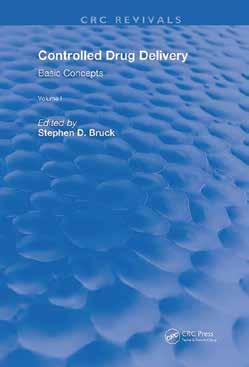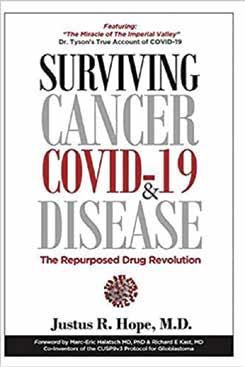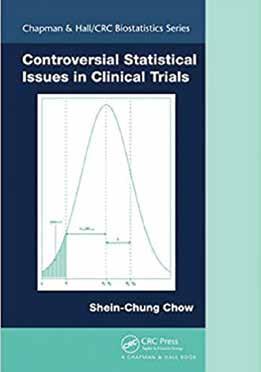
12 minute read
BOOKS
Controlled Drug Delivery: Volume 2 Clinical Applications (Routledge Revivals)
Author: Stephen D Bruck
Advertisement
Year of Publishing: 2019
No. of Pages: 257
Description: Product Description: Published in 1983: Volume 2 deals with critical analyses of various test methodologies of polymeric implants, including their acute and chronic toxicological evaluation. Surviving Cancer, COVID-19, and Disease: The Repurposed Drug Revolution

Author: Justus R Hope
Year of Publishing: 2020
No. of Pages: 420
Description: Product Description: This book explains in easy-to-understand words the science behind repurposed drugs, commonly used pills already in your medicine cabinet that can kill cancer stem cells, the roots of cancer. Cancer stem cells are STIMULATED to REGROW and SPREAD and create resistance by standard treatments of chemotherapy, surgery, and radiation - THIS is the reason "cancers return and kill patients almost half the time." There are ways to stop cancer stem cells and he explains them in the book. Controversial Statistical Issues in Clinical Trials

Author: Shein-Chung Chow
Year of Publishing: 2020
No. of Pages: 616
Description: The book focuses on issues occurring at various stages of clinical research and development, including early-phase clinical development (such as bioavailability/bioequivalence), bench-to-bedside translational research, and late-phase clinical development. Numerous examples illustrate the impact of these issues on the evaluation of the safety and efficacy of the test treatment under investigation. The author also offers recommendations regarding possible resolutions of the problems.
Analytical Testing for Pharmaceutical Industry in this Digital Age
Joachim Weiss, Technical Director, Dionex Products, Thermo Fisher Scientific
Other spokespersons
Rich Youn, Senior Commercial Director, Commercial Operations, Asia Pacific and Japan (APJ) for Chromatography and Mass Spectrometry group, Thermo Fisher Scientific
Ruby Ong, Senior Marketing Manager, Asia Pacific and Japan (APJ) for Chromatography and Mass Spectrometry group, Thermo Fisher Scientific
Wai-Chi Man, Product Marketing Manager for Ion Chromatography, Thermo Fisher Scientific
What are the major trends shaping the developments of the pharmaceutical industry in Asia?
Rich Youn: As the hotbed of technological developments, Asia is riding the wave of global mega trends which include aging population, digitalisation, and the adoption of emerging technologies such as Artificial Intelligence (AI) and the Internet of Things (IoT).
These trends impact the pharmaceutical industry because as the population ages, we find that governments focus on making healthcare accessible, which in turns lead to lower drug prices. Ultimately, this brings pressure on the costs of drug production.
In the meantime, the global pharmaceutical industry is leveraging technologies towards Pharma 4.0 for connectivity, digitalisation and artificial intelligence in the development and manufacturing of pharmaceutical and biotechnology products. Would the global pandemic in 2020 impact the adoption of new technologies or the pharmaceutical industry’s transformation to Pharma 4.0? Rich Youn: According to industry research firms, AI for the drug discovery and development market grew significantly due to the pandemic. The global AI for drug discovery and development market could reach US$4.81 billion by 2027 and attributed the rise in number of partnerships between AI providers and pharma and biotech companies to the development of drugs for treatment of patients affected from coronavirus as well as to helping scientists understand the protein structure of the virus, playing an integral role in drug design and accelerating vaccine technologies.
How does the pharmaceutical industry’s transformation to Pharma 4.0 impact companies like Thermo Fisher Scientific?
Rich Youn: Due to the pandemic, the world is expecting unprecedented progress from the scientific community. Thermo Fisher Scientific is focused on driving innovations in technology that can help the scientific community to power discovery, improve productivity, and enable breakthroughs across a variety of applications.
Additionally, our team in the Asia Pacific Japan (APJ) region has been proactively making efforts to strengthen and empower a stronger and more knowledgeable community
of scientists, chemists, and laboratory professionals in Asia by facilitating knowledge sharing sessions.

Can you give an example of the knowledge sharing sessions? And why would the scientific community participate in these?
Rich Youn: Yes, for instance, Thermo Fisher Scientific had worked on virtual learning series and live video forums known as ‘Pharma 4.0: Transforming Pharmaceutical Manufacturing’ for participants from more than 12 locations across the APJ region. This series enabled them to meet with experts worldwide on pertinent issues such as regulatory and quality challenges, emerging technologies, and transformation to the laboratory of the future.
That series was in September 2020 while in June 2020, we held a successful virtual LCMS conference to empower learning for Asia’s lab professionals embarking on intelligence-driven mass spectrometry. In October, we held the Global Ion Chromatography Virtual Symposium for participants in Asia, Europe and the Americas.
For the scientific community such as laboratory professionals including scientists, researchers and chemists, they want to move science forward with confidence, scale research and translate results faster and simpler than before.
More importantly, they want a new generation of intelligence-driven instruments and software that will enable them to acquire data more quickly and with greater accuracy than ever before.
It is imperative that we support their needs and desires to push the frontiers of science. Through knowledge sharing, we can work as one with the scientific community to progress for the greater good of society.
In 2020, we understand that Thermo Fisher Scientific celebrated 45 years of Ion Chromatography. Would you like to share with us the highlights of this milestone for the scientific community? Ruby Ong: Ion chromatography is one of the most widely used separation techniques of analytical chemistry with applications in fields such as medicinal chemistry, water chemistry and materials science.
For ion analysis, nothing compares to the Thermo Scientific™ Dionex™ Ion Chromatography (IC) system. In 2020, the company marked 45 years of Thermo Scientific Dionex IC celebration with innovative technology. We are
committed to ensuring that our IC systems continue to be future-ready, helping laboratory professionals be more productive, be safer with less chemical handling and maximise their resources.
The company’s key technological advancements for IC include: • Eluent Generation (EG) – Eluent generation is an electrolytic process that allows the production of high purity eluents for ion chromatography, and is a part of ReagentFree Ion Chromatography™ (RFIC™) • Reagent-free ion chromatography - Eliminate eluent preparation errors with RFIC. Using our Dual EG technology, lab professionals no longer have to manually prepare hydroxide and sodium acetate to analyse oligosaccharides • Hyphenated IC – Lab professionals can hyphenate ion chromatograph systems to gain an abundance of information instead of just using conductivity or amperometry as their IC detection. Hyphenate it with an inductively coupled plasma mass spectrometry (ICP-MS) to speciate transition metals to decipher toxic versus non-toxic; add an UV-Vis in serials to the IC in order to gain chromophoric information and sensitivity such as nitrate in high anionic content.
We understand that there is a special eBook on IC for readers of Pharma Focus Asia? Ruby Ong: Yes, to commemorate the significance of this 45-year anniversary, we have a new eBook on IC authored by Joachim Weiss, PhD, Technical Director for Dionex Products at Thermo Fisher Scientific. Weiss is recognised as an international expert in analytical chemistry, and the 4th edition of his Handbook of Ion Chromatography was published in 2016. In 2015, he was awarded the Maria Sklodowska Curie Medal of the Polish Chemical Society for his achievements in separation science.
May we hear from Joachim Weiss more about this e-Book? Joachim Weiss: Thank you for the opportunity to do this interview. Let me share my thinking behind this new IC eBook.
With the publication of Hamish Small’s legendary paper in Analytical Chemistry in 1975, 2020 marks the 45th anniversary of the introduction of Ion Chromatography. Over these four decades, ion chromatography has not only become the most dominant method in ion analysis, but also developed into a significant chromatographic technique within the field of separation science. While in its earliest embodiments, IC was focused primarily on the analysis of inorganic anions, today IC has an important role in the analysis of organic and inorganic anions and cations.
Recently, I was looking for a comprehensive, but succinct, resource that explains the basics of ion chromatography. To my surprise, I did not find any compact source or comprehensive text on this subject, apart from my three-volume Handbook of Ion Chromatography that was published as a 4th edition in 2016. Since this is, by far, too detailed, I decided it was necessary to create such a document myself.
Therefore, I have developed an eBook, Basics of Ion Chromatography, for analytical chemists who are looking for an up-to-date introduction to ion chromatography, providing an overview on the major topics related to this expanding and increasingly important field of science.
Separation methods, stationary phases, and detection principles offered by Thermo Fisher Scientific as well as the most important application areas are covered. The eBook is not limited to methods for analysing inorganic anions and cations only, lab professionals will also find a compact description on modern carbohydrate and amino acid analyses as well as high-resolution separations of oligonucleotides and proteins.
On the topic of chromatography, you have over 30 years of experience in ion chromatography and 20 years of experience in the pharma industry, would you be able to provide insights on how lab professionals use IC for pharmaceutical impurity analyses?
Wai-Chi Man: In most pharmaceutical laboratories, IC is mostly used for salt screening for intermediates and drug substances. In recent years, we have seen more and more small polar impurities that affect the drug discovery process and drug safety. With newer technology, we are often competing with other techniques when we should be using multiple orthogonal methods to confirm the impurity. IC is uniquely placed for small charged polar compounds for reproducible methods from research to manufacturing QC/QA laboratories. It can even analyse carbohydrates and amino acids without derivatisation.
Scan the QR Code or
AUTHOR BIO
Joachim Weiss is an international expert in analytical chemistry and is presently the International Technical Director for Dionex Products at Thermo Fisher Scientific. He is recognised as an international expert in Analytical Chemistry, especially in the field of Liquid/Ion Chromatography. For his achievements in separation science, Weiss was awarded the Maria Sklodowska Curie Medal of the Polish Chemical Society in 2015.
Recently we have seen how Nitrosamine has impacted the pharma Industry. To minimise the impact, at the final drug substance stage impurities such as nitrite and nitrate can be monitored routinely from starting material through to all the intermediate stages, using IC with conductivity detection. Other break-down impurities, whether it is stability testing or process generated into small organic acids or amines can also be quantified by IC. Potential small toxic impurities such as hydrazine, cyanide, and many more charged species can be detected by IC to low ppb levels, especially using hyphenated techniques.
More commonly used as a hyphenated IC technique is conductivity with UV-Vis detection in series for high-low matrices. To enable confirmation of small unknown impurities Mass Spectrometry (MS) can be used with IC to elucidate retention and mass identification. IC-MS is extremely useful for genotoxins that are small, polar, and halogenated. IC hyphenation of the elemental kind with an Inductively coupled plasma mass spectrometer (ICP-MS), often used for speciation for inorganic or organic species.
In challenging pharmaceutical impurity analysis, should lab professionals use IC and IC-MS? Wai-Chi Man: Most definitely. There are many challenges in pharmaceutical laboratories, from degradation to process impurities. From experience, there have been too many times that I have encountered those challenges. They usually come from a comment of “that doesn't look right”. It can be from a simple coating formed on the glass sample vial for the starting material to a mass imbalance at the final drug substance stage. Using the combination of IC and MS data, we can cover salt screening to unknown ionic impurities.
We have seen how MS has impacted liquid chromatography (LC) in the last few decades. LC-MS is now commonly used for troubleshooting and routine analysis. It is because LC-MS can reach low ppt levels to identify the impurity by mass and can be easily automated. In similar ways, IC is also capable of the same performance but for charged ionic species. In many ways, IC uses ion exchange chemistry to elute its analytes using size-to-charge ratios. It provides good resolutions for the low mass size that usually ends up in the solvent front in LC or just not enough chromophore for UV-Vis detection. IC-MS detection can simplify some of the sample preparation as derivatisation to add chromophore or fluorescence is not required, with the combination of IC eluent, ion exchange column, and suppression technology to neutralise the background.
Lastly, can Thermo Fisher Scientific tell us more about the use of IC-MS in pharma QA/QC environments? Joachim Weiss: Unlike liquid chromatography – mass spectrometry (LC-MS), which starts to find its way into QA/QC pharmaceuticals, ion chromatography – mass spectrometry (IC-MS) is currently not applied but under evaluation.
Since ion chromatography is part of liquid chromatography, I do not see any reason why IC-MS should not be applied in QA/QC in future. While for some IC applications in the pharmaceutical industry, such as the analysis of anionic and/or cationic counter ions, suppressed conductivity is the detection method of choice, I see the need for complementary detection methods such as MS when analysing organic acids.
Even utilising the most modern commercially available anion exchangers in the 4 µm format, baseline separations of small-molecular weight mono- as well as dicarboxylic acids from other anionic sample constituents (e.g., inorganic anions) are difficult, so that suppressed conductivity detection cannot be applied for an immaculate quantitation. However, all these organic acids differ in nominal mass, so that a single quadrupole MS detector in SIM mode can be employed.
The latest generations of such MS detectors are very easy to use and robust, so that I do not see any obstacle for using them in a QA/QC environment. The same is true in the analysis of amines, another very important application for IC in the pharmaceutical industry. Here we have a very similar scenario: individual aliphatic amines or quaternary ammonium compounds can usually be separated from inorganic cations such as alkali and alkaline-earth metals, but if the sample contains a larger number of amines or the analytes are present in very disparate concentrations ratios partial co-elution are often observed. In such situations, IC-MS might serve as a welcome alternative for detection.










